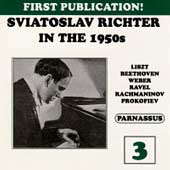Click HERE to go back to the Richter Page.
Sviatoslav Richter Live in the 1950s: Fanfare Review

Older readers may remember the shock of discovery when the first of Sviatoslav Richter's discs made their way to the West. Since his first US tour in 1960, of course, he has been a fixture in the American musical imagination (although not in our concert halls), and we have been able to sample a far wider selection of his art in vastly better sound than that afforded by those early LPs. Still, as Richard Taruskin reminded us in an eloquent appreciation (13:3, p. 244), the Richter of the 1950s and early 1960s was a substantially more febrile artist than the "courtly, white-mustnchioed elder statesman" he has become--snd it is therefore not just nostalgia that gives his early recordings their magnetic chraracter. BMG's ten-disc celebration, reviewed in detail by Leslie Gerber in 19:3, resurrected a significant number of scorching early studio recordings. The five discs under review, although they retrace much of the some repertoire, document live performances, sometimes a bit sloppier than the studio versions, but often fueled by an even more impetuos spirit and reaching an even higher emotional temperature.
This is especially evident in the stunning, four-disc salvo from Gerber's own Parnassus Records, which brings us five hours of new recordings, in surprisingly serviceable sound, that have apparently never been released before. The contents consist largely of early-Richter staples-but the high-contrast peformances are, without exception, knockouts. All of Richter's interpretations demonstrate a staggering diversity of touch (note how his hard-bitten account of Rachmaninov's op.32/7 melts away at the end) and an almost unerring rhythmic control, both of small gestures and of larger paragraphs--note, for instance, how the Chopin Etude, op. lO/I, explodes forth as a single utterance. But what marks Richter's early virtuoso efforts in particular is the way these qualities combine to grip you, rather than persuade you. There are other Richter performances that are more lighthearted (for instance, his four-hand Mozart with Britten; see 16:1); there are others, like his early 80s Tokyo Prokofiev (17;3), that offer more density of detail; and there -are certainly others (most notably his contoversial Schubert Bb, 6:4; see Michael Ullman's dissent in 14:4) that convey deeper philosophical insights. But his early performances have a demonic intensity that was often tempered in his later years; and these four discs offer ample opportunity to experience, undiluted, the aural adrenaline rush that Taruskin described.
Certainly, no one else manages to steer through the Schumann Toccata with such brio, largely because no one else, not even Horowitz, manages to shape the music's syncopations so that the textures never clot. In part because of a quicker tcmpo, but also in part because of a greater sense of abandon, this fierce account of the finale of the Prokofiev Seventh is even mord overwhelming than his famous studio version. And despite moments of apparent brusqueness (patience is not in high supply on these discs), this 1953 dash through Pictures is so impulsive as to make his classic Sofia account seem almost blasé.
I don't mean to suggest that these are relentlessly steely readings in the manner of Simon Barere. Richter has an astonishing capacity for elegance. too (try the sixth of the Prokofiev Visions) and his Rachmaninov, like the first movement of his Scriabin Second, can be extremely lush: try, for instance, the superb weighting of the cadences on op. 23/4. But when, for instance, he heightens the contrast of the first movement of the Tchaikovsky Sonata by sweetening up the second theme, he manages to do so without dissipating the sense of urgency--transforming, by sheer willpower, the music's redundancy into propulsion. There are claws beneath the velvet passages in this chipper Tchaikovsky Concerto as well; and although his Scriabin Sixth and his Schumann Humoresque both manifest a remarkable sympathy for the music's mercurial swings, there is an underlying edge to both works that is apt to keep you off balance. Given the extent to which the Parnassus repertoire duplicates that of recordings already in the catalog (more or less contemporaneous performances with a similar interpretive slant and superior sound), I will resist the temptation to promote these discs as the best introduction to Richter's art of the 1950s: but Richter aficionados should find them an invaluable supplement to their collections. Highly recommended.
Peter J.Rabinowitz; Fanfare May/June 1997





 Created on
Hippie 98 by Mark Zip.
Created on
Hippie 98 by Mark Zip.